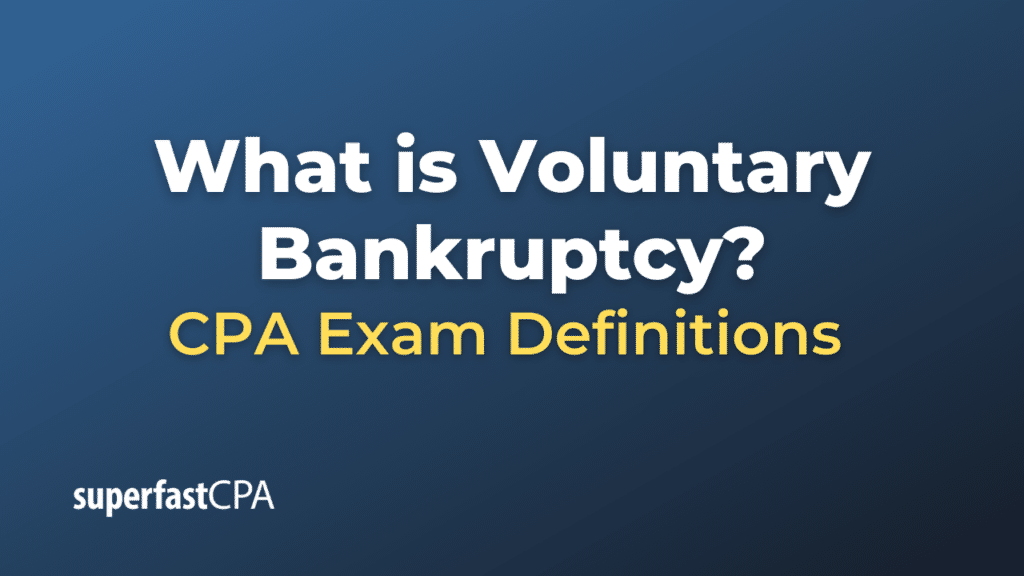Voluntary Bankruptcy
Voluntary bankruptcy is a legal proceeding initiated by an individual or a business entity to seek relief from debts they cannot pay back. Unlike involuntary bankruptcy, where creditors force the debtor into bankruptcy proceedings, voluntary bankruptcy is initiated by the debtor themselves.
Voluntary bankruptcy allows debtors to either liquidate their assets to pay off debts (Chapter 7 in the United States) or develop a repayment plan to pay back debts over time (Chapter 13 for individuals and Chapter 11 for businesses in the United States). The specific chapters and rules can vary by jurisdiction.
Reasons for Voluntary Bankruptcy:
- Debt Relief : An overwhelming amount of debt that the debtor realizes they cannot pay back.
- Asset Protection : Filing for bankruptcy can provide some legal protection against asset seizure by creditors.
- Stopping Harassment: It can stop persistent creditor harassment, as most collection actions are halted once bankruptcy is filed.
- Reorganization: For businesses, it can provide an opportunity to restructure and streamline operations under court supervision.
- Fresh Start: After debts are discharged, individuals and businesses can often start anew, albeit with a significant impact on their credit rating.
Procedure:
- Consultation with an Attorney: Given the complexity and long-term implications of bankruptcy, consulting with an attorney specialized in bankruptcy law is usually the first step.
- Filing a Petition : The debtor files a bankruptcy petition in the bankruptcy court, which includes details on their financial condition, assets, debts, income, and a list of all creditors.
- Automatic Stay: Once the petition is filed, an “automatic stay” is typically imposed, stopping most collection actions against the debtor.
- Trustee Appointment : In most cases, a trustee is appointed to oversee the debtor’s case, including asset liquidation or repayment plans.
- Creditors Meeting : Creditors have a chance to question the debtor in a court-supervised meeting.
- Discharge or Repayment Plan : Depending on the bankruptcy chapter, debts are either discharged or a court-approved repayment plan is initiated.
Consequences:
- Credit Score: A significant negative impact on the debtor’s credit score.
- Asset Loss : Potential loss of assets, depending on the bankruptcy type and jurisdiction.
- Public Record: Bankruptcy becomes a matter of public record, which could impact future employment and business endeavors.
- Restrictions: There may be limitations on filing for bankruptcy again in the future.
Example of Voluntary Bankruptcy
Let’s consider a hypothetical example of a small tech startup named “TechSolve” facing financial hardship and opting for voluntary bankruptcy.
Background:
TechSolve specializes in creating software solutions for small businesses. The company was launched three years ago and initially showed promise with growing sales and a loyal customer base. However, due to a market downturn and increased competition, the company has been struggling for the last year. After evaluating their financial situation and failing to secure additional financing, the founder, Jane, decides to consult a bankruptcy attorney.
Financial Situation:
- Total Debts : $500,000 (includes business loans, credit card debt, and outstanding payments to vendors)
- Monthly Revenue: $10,000 (down from $50,000 a year ago)
- Monthly Expenses: $40,000 (includes salaries, office rent, utilities)
- Cash on Hand: $20,000
Decision to File for Voluntary Bankruptcy:
Jane consults a bankruptcy attorney and reviews the options. Given that the company is insolvent and cannot meet its debt obligations, Jane decides to file for voluntary bankruptcy under Chapter 11, aiming to restructure the business.
Steps Taken:
- Filing a Petition : Jane files the required documents with the bankruptcy court, including a list of all assets, debts, income, and a list of creditors.
- Automatic Stay: An “automatic stay” goes into effect, halting all debt collection activities against TechSolve.
- Meeting of Creditors: A meeting with creditors is scheduled. Jane presents her case, explaining the downturn in business and her plans for restructuring.
- Repayment Plan : With the help of her attorney and financial advisors, Jane prepares a reorganization plan to present to the court, outlining how she intends to keep the business running while paying off debts.
- Court Approval: The court reviews the plan, and after some negotiations with the creditors, it gets approved.
Outcome:
Under the new repayment plan, TechSolve agrees to:
- Close one of its two offices to reduce overhead costs.
- Lay off some non-essential staff and retain only the core team.
- Renegotiate contracts with vendors.
- Commit to repaying creditors a fixed amount each month based on a percentage of revenue, over a five-year period.
Aftermath:
- TechSolve manages to stay in business, albeit in a downsized form.
- Jane can keep her core team and focus on rebuilding the customer base.
- Creditors get a better deal than they would if TechSolve went into liquidation, even though they have to accept a reduced repayment.
Although the bankruptcy severely impacts Jane’s credit score and the reputation of TechSolve, it allows her a chance to restructure and work towards a more financially stable future.
This example illustrates how voluntary bankruptcy can serve as a last resort for businesses or individuals facing overwhelming financial difficulties, giving them an opportunity for a fresh start while complying with legal obligations to creditors.













